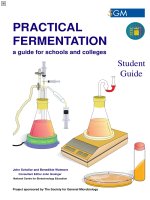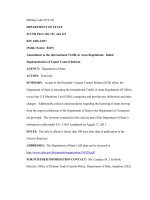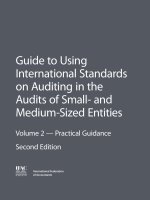- Trang chủ >>
- Mầm non - Tiểu học >>
- Lớp 2
solution to fifth international mathematics assessment for schools round 1 of middle division
Bạn đang xem bản rút gọn của tài liệu. Xem và tải ngay bản đầy đủ của tài liệu tại đây (312.86 KB, 10 trang )
<span class='text_page_counter'>(1)</span><div class='page_container' data-page=1>
<b>Solution to </b>
<b>Fifth International Mathematics Assessment for Schools </b>
<b>Round 1 of Middle Division </b>
1. What is the value of 2016−20 16× ?
(A)1696 (B)1698 (C)1706 (D)1716 (E)1726
【Solution】
2016−20 16× =2016 320 1696− = .
Answer:(A)
2. Cubes of side length 1 cm are available in two colors. They are used to form a
large cube of side length 3 cm, and two small cubes sharing a common face have
different colors. What is the positive difference between the numbers of cubes in
the two colors?
(A)0 (B)1 (C)2 (D)3 (E)4
【Solution】
Since any two small cubes sharing a common face have different colors, the
arrangement of the cubes at the top, middle and bottom levels should be of the
following forms respectively:
The positive difference between the numbers of cubes in the two colors is 1.
</div>
<span class='text_page_counter'>(2)</span><div class='page_container' data-page=2>
3. How many different rectangles (including squares) in different positions are there
in the diagram below?
(A)5 (B)6 (C)7 (D)8 (E)9
【Solution】
In the diagram, there are two kinds of rectangles:
(i) those formed by a single rectangle (including square):
there are 5 such rectangles in different positions;
(ii) those formed by two rectangles:
in , there is one such rectangle; in , there is another such rectangle;
so there are 2 such rectangles in different positions.
Thus there are totally 5+ =2 7 rectangles in different positions.
Answer:(C)
4. In a 6 by 6 table, each row and each column contains the letters <i>A</i>, <i>B</i>, <i>C</i>, <i>D</i>, <i>E</i> and
<i>F</i> exactly once. All but four of the squares have been filled in. Which of the
following should be chosen to fill in the blank squares?
<i>A B</i> <i>C</i> <i>D</i> <i>E</i> <i>F</i>
<i>B </i> <i>C</i> <i>D</i> <i>E</i> <i>F</i> <i>A</i>
<i>C </i> <i>D</i> <i>E</i> <i>F</i> <i>A</i> <i>B</i>
<i>D </i>
○
1○
2 <i>A</i> <i>B</i> <i>C</i><i>E </i>
○
3○
4 <i>B</i> <i>C</i> <i>D</i><i>F A</i> <i>B</i> <i>C</i> <i>D</i> <i>E</i>
(A) <i>E F </i>
<i>C D </i> (B)
<i>E</i> <i>F</i>
<i>F</i> <i>A</i> (C)
<i>E F</i>
<i>A B</i>
(D) <i>A B</i>
<i>C D</i> (E)
<i>B</i> <i>C </i>
<i>C</i> <i>D </i>
【Solution】
Since there is no <i>A </i>in the fifth row and in the third column,
○
4 should be filled with <i>A</i>.Similarly,
○
1 should be filled with <i>E</i>. Finally○
2 and○
3 should be filled with <i>F</i>.</div>
<span class='text_page_counter'>(3)</span><div class='page_container' data-page=3>
5. The letters IMAS are spelt out with the same size of black and white circles as
shown in the diagram below. If the total area of the black circles is 50 cm2 , what
is the total area, in cm2 , of the white circles?
(A)26 (B)28 (C)30 (D)32 (E)34
【Solution】
There are 25 black circles and 15 white circles. Since the total area of the black
circles is 50 cm2 , the area of each circle is 50÷25=2cm2. So the total area of the
white circles is 2 15× =30 cm2.
Answer:(C)
6. Barry is flying from A to B on a 13:00 flight. The distance between A and B is
1800 km, and the speed of the plane is 600 km per hour. If the flight is delayed
for 2 hours and no time difference between A and B, when will Barry arrive at B?
(A)15:00 (B)16:00 (C)17:00 (D)18:00 (E)19:00
【Solution】
The flying time is 1800 600 3÷ = hours from A to B and the flight started at 15:00.
So Barry will arrive B at 18:00.
Answer:(D)
7. Jane feeds her cat at regular intervals. The first feeding is at 7:00 and the sixth
feeding is at 22:00. Which of the following is not a feeding time for the cat?
(A)10:00 (B)12:00 (C)13:00 (D)16:00 (E)19:00
【Solution】
Jane feeds her cat six times from 7:00 to 22:00. So the interval between successive
feedings is (22 7) 5 3− ÷ = hours. Thus the feeding times are 7:00, 10:00, 13:00,
16:00, 19:00 and 22:00, except 12:00.
</div>
<span class='text_page_counter'>(4)</span><div class='page_container' data-page=4>
8. If Mary buys 3 dolls, she will have 150 dollars left. If she buys
4 dolls, she will be 50 dollars short. All the dolls are at the
same price. How much money does Mary have on her?
(A)450 (B)550 (C)650
(D)750 (E)850
【Solution】
The price of each doll is 150 50+ =200 dollars. So Mary has 3 200 150× + =750
dollars.
Answer:(D)
9. How many four-digit numbers using each of 0, 2, 4 and 5 once are divisible by 5?
(A)4 (B)6 (C)8 (D)10 (E)12
【Solution】
The units digit of a four-digit number is 0 or 5 if it is divisible by 5.
If the units digit of the four-digit number is 0, then there are 6 four-digit numbers,
namely 2450, 2540, 4250, 4520, 5240 and 5420, satisfying the conditions.
If the units digit of the four-digit number is 5, then there are only 4 four-digit
numbers, namely 2045, 2405, 4025 and 4205, satisfying the conditions since the
leading digit of a four-digit number cannot be 0.
So there are totally 6+ =4 10 four-digit numbers satisfying the conditions.
Answer:(D)
10. Four teachers predict the order of finish among five classes, as shown in the table
below. Every prediction is wrong! In which place does Class 2 finish?
1st 2nd 3rd 4th 5th
Teacher A Class 4 Class 3 Class 2 Class 5 Class 1
Teacher B Class 4 Class 2 Class 5 Class 3 Class 1
Teacher C Class 3 Class 1 Class 4 Class 2 Class 5
Teacher D Class 1 Class 5 Class 2 Class 4 Class 3
(A)1st <sub>(B)2</sub>nd <sub>(C)3</sub>rd <sub>(D)4</sub>th <sub>(E)5</sub>th
【Solution】
Since teacher A, B, C and D predict Class 2 to be 3rd, 2nd, 4th and 3rd, respectively, and
all of their predictions are wrong, Class 2 finishes in 1st or 5th place.
Since teacher A, B, C and D predict Class 5 to be 4th, 3rd, 5th and 2nd, respectively, and
all of their predictions are wrong, Class 5 finishes in 1st place.
Now we can conclude that Class 2 finishes in 5th place.
Answer:(E)
11. A new arithmetic operation “∇” is such that 6 3∇ =218、8 4∇ =232 and
9 3∇ =327. What is the value of 10 2∇ ?
(A)125 (B)205 (C)250 (D)520 (E)525
【Solution】
The product of the two given numbers forms the last two digits of the result and the
leading digit of the result is the quotient when the first number is divided by the
second. So 10 2∇ =520.
</div>
<span class='text_page_counter'>(5)</span><div class='page_container' data-page=5>
12. A bamboo stick is lowered vertically into water to a depth of 50 cm, and a mark
is made on the stick at the point of immersion. The stick is then taken out and
turned upside down. Then it is lowered vertically into water to a depth of 50 cm,
and a mark is made on the stick at the point of immersion. If the distance
between the two marks is 25 cm, what are the possible lengths, in cm, of the
bamboo stick?
(A)75 (B)100 (C)125 (D)75 or 125 (E)150 or 250
【Solution】
If the bamboo stick was immersed twice in water without overlapping portions, the
length of the bamboo is 50 50+ +25 125= cm. If the bamboo stick was immersed
twice in water with overlapping portions, the length of the bamboo is
50+50−25=75cm. So the possible lengths of the bamboo stick is 75 or 125 cm.
Answer:(D)
13. If a boy is chosen as captain, then the number of boys among the other members
is equal to the number of girls. If a girl is chosen as captain, then the number of
girls among the other members is one half the number of boys. How many boys
are there?
(A)2 (B)3 (C)4 (D)6 (E)8
【Solution1】
When boy is chosen as captain, the number of boys among the other members is
equal to the number of girls. So the number of boys is 1 more than the number of
girls and hence when a girl is chosen as captain, the number of boys is 2 more than
the number of girls among the other members. As we already know that in this
situation, the number of girls among the other members is one half the number of
boys, so the number of girls among the other members is 2. Thus the number of boys
is 2 2× =4.
【Solution2】
Assume there are <i>x</i> boys. Then there are <i>x</i>−1 girls. From the given conditions,
2( 1 1)
<i>x</i>= <i>x</i>− − . Thus <i>x</i> =4.
Answer:(C)
14. Use all of the numbers 1, 2, 3, 4, 5, 6, 7 and 8 to fill in the circles in the diagram
below so that the sum of the numbers in the four circles of each of the two
squares and each of the four trapezoids is constant. What is this constant sum?
</div>
<span class='text_page_counter'>(6)</span><div class='page_container' data-page=6>
【Solution】
If we add the sums of the numbers in the four circles of the two squares and the four
trapezoids, then the number in each circle is counted three times. So the sum is
3 (1 2× + + + + + + + =3 4 5 6 7 8) 108. Since the sum of the numbers in the four circles
of each of the two squares and each of the four trapezoids is constant, this constant is
108 6 18÷ = . The following figure shows a way to fill those numbers.
Answer:(E)
15. Four identical dice are stacked on a desk, as shown in the diagram below. How
many spots are on the face of the bottom die touching the top of the desk?
(A)1 (B)3 (C)4 (D)5 (E)6
【Solution】
For the top die, the face containing 1 spot is adjacent to the faces containing 2 and 5
spots. For the second die, the face containing 1 spot is adjacent to the faces
containing 4 spots. For the third die, the face containing 1 spot is adjacent to the faces
containing 3 spots. Thus we know the face containing 6 spots is the opposite face of
the face containing 1 spot. For the bottom die, the front face is the face containing 2
spots and the right face is the face containing 4 spots, so the face of the bottom die
touching the top of the desk contains 1 or 6 spots. If it contains 1 spot, then the right
face contains 5 spots, which is a contradiction. So the face of the bottom die touching
the top of the desk contains 6 spots.
Answer:(E)
16. <i>C</i> and <i>D</i> are two points on the segment <i>AB</i>, as shown in the diagram below. If <i>AD</i>
is 30 cm longer than <i>BD</i> and <i>AC</i> is 14 cm shorter than <i>BC</i>, what is the length, in
cm, of <i>CD</i>?
(A)22 (B)24 (C)26 (D)28 (E)30
6
2
7
3
8
4 5
1
</div>
<span class='text_page_counter'>(7)</span><div class='page_container' data-page=7>
ĪSolutionī
From the given conditions, <i>AD</i>-<i>BD </i>= <i>AC </i>+ <i>CD</i>-<i>BD </i>= 30 cm and <i>BC</i>-<i>AC </i>= <i>BD </i>+
<i>CD</i>-<i>AC </i>= 14 cm. Adding the two equations, we get 2<i>CD</i>=44 cm. Thus <i>CD</i>= 22
cm.
Answer:(A)
17. Simultaneously, X and Y start going from <i>A</i> to <i>B</i> while Z goes from <i>B</i> to <i>A</i>, each
at a different constant speed. Z's speed is 3 times that of X. Ten minutes after
their start, Y meets Z, and 10 minutes later, X meets Z. How many minutes will it
take for Y to complete the whole trip?
(A)10 (B)12 (C)14 (D)16 (E)18
【Solution 1】
Clearly, twenty minutes after their start, X meets Z. Since the speed of Z is three
times that of X, X completes the 1
4 of the trip and Z completes the
3
4 of the trip.
Thus Z completes the 3 2 3
4 ÷ =8 of the trip in ten minutes and hence Y completes the
3 5
1
8 8
− = of the trip in ten minutes. So Y needs 10 5 16
8
÷ = minutes to complete the
whole trip.
【Solution 2】
Assume the speed of X is <i>x</i>, then the speed of Z is 3<i>x</i>. Twenty minutes after their start,
X meets Z. So the length of the trip is (3<i>x</i>+ ×<i>x</i>) 20=80<i>x</i>. And ten minutes after their
start, Y meets Z. So the sum of the speed of Y and Z is 80<i>x</i>÷10=8<i>x</i>. Thus the speed
of Y is 8<i>x</i>−3<i>x</i>=5<i>x</i> and hence Y needs 80<i>x</i>÷5<i>x</i>=16 minutes to complete the
whole trip.
Answer:(D)
18. Hanna makes four straight cuts on a round cake. Into at
most how many pieces can she cut it?
(A)8 (B)10 (C)11
(D)12 (E)14
【Solution】
We need to find how many parts a circle can be divided into at
most by 4 lines. A circle can be divided into at most 2 parts by a
line. If we draw another line, then each side of the original line
can be divided into at most 2 parts. So a circle can be divided
into 4 parts at most by two lines. If we draw the third line, then
each side of the original two lines can be divided into at most 2
parts. But one part is counted twice, hence a circle can be
divided into at most 4 + 3 = 7 parts by three lines. If we draw the
fourth line, then each side of the original three lines can be
divided into at most 2 parts. But two parts are both counted
</div>
<span class='text_page_counter'>(8)</span><div class='page_container' data-page=8>
19. Eight children are sharing 61 balloons. Each gets at least one, and everyone
receives a different number. What is the smallest number of balloons that can go
to the child receiving more balloons than the others?
(A)10 (B)12 (C)14 (D)16 (E)18
【Solution 1】
In order to get the smallest number of balloons that can go to the child receiving more
balloons than the others, the other seven children should get as many balloons as
possible. Suppose the eight children receive 1, 2, 3, 4, 5, 6, 7 and 8 balloons first and
hence they get totally 1 2 3 4 5 6+ + + + + + + =7 8 36 balloons. There are still
61 36− =25 balloons left. Next, let each child receives 3 more balloons. Thus the
eight children receive 4, 5, 6, 7, 8, 9, 10 and 11 balloons. Finally, let the child who
receives 11 balloons receives the last balloon. So the smallest number of balloons that
can go to the child receiving more balloons than the others is 12.
【Solution 2】
If the number of balloons that can go to the child receiving more balloons than the
others is 11, than there are at most 4 5 6+ + + + + +7 8 9 10 11 60+ = balloons since
everyone receives a different number. This contradicts with that they are sharing 61
balloons. So the number of balloons that can go to the child receiving more balloons
than the others is 12 while the eight children receive 4, 5, 6, 7, 8, 9, 10 and 12
balloons.
Answer:(B)
20. In how many ways can we choose six different numbers from 1, 2, 3, 4, 5, 6, 7
and 8 so that their sum is a multiple of 4?
(A)6 (B)8 (C)12 (D)16 (E)24
【Solution】
Since 1 2 3 4 5 6+ + + + + + + =7 8 36 is a multiple of 4, as we choose six different
numbers so that their sum is a multiple of 4, the sum of the remainder two numbers
must be a multiple of 4, and vice versa. The ways to choose two different numbers so
that their sum is a multiple of 4 are (1, 3), (1, 7), (2, 6), (4, 8), (5, 3) and (5, 7). There
are 6 ways.
Answer:(A)
21. In reading a story book, Lance reads one page more each day than the preceding
day. On the fourth day, he reads 39 pages. After 9 days, he still has 48 pages to go.
How many pages are there in this book?
【Solution】
Since Lance reads 39 pages on the fourth day, he reads 39 3− =36 pages on the first
day. So he has read 36, 37, 38, 39, 40, 41, 42, 43 and 44 pages in the first nine days.
Thus there are 36+37+38+39+40+41 42+ +43+44+48=408 pages in this
book.
</div>
<span class='text_page_counter'>(9)</span><div class='page_container' data-page=9>
22. The diagram below shows two overlapping rectangles consisting of region I,
region <b>II and the shaded region. The area of the rectangle </b><i>ABCD</i> is 6 times the
area of the shaded region. The total area of the regions I and II is 9 times the area
of the shaded region. The region II has area 12 cm2 . What is the area, in cm2 , of
the shaded region?
【Solution】
The area of the region <b>I</b> is 6 1 5− = times of the area of the shaded region, so the
area of the region <b>II</b> is 9 5− =4 times of the area of the shaded region. Since the
region <b>II</b> has area 12 cm2 , the area of the shaded region is 12÷ =4 3 cm2.
Answer:003
23. Fanny has 20 coins each worth 5 pence. Trading some of them for coins each
worth 2 pence, she ends up with 32 coins. Then she trades some more 5-pence
coins for coins each worth 1 penny, and now she has 56 coins. How many
5-pence coin does Fanny still have?
【Solution】
Two 5-pence coins can be exchanged with five 2-pence coins and hence there are 3
more coins after such an exchange. Since Fanny has 32 20 12− = more coins after
the first trading, she has taken 12 3 2 8÷ × = 5-pence coins for the first trading.
Similarly, one 5-pence coin can be exchanged with five 1-penny coins and hence
there are 4 more coins after such an exchange. After second trading, Fanny has
56 32− =24 more coins, so she has taken 24 4 6÷ = 5-pence coins for the second
trading. Thus she still have 20 14 6− = 5-pence coins.
Answer:006
24. Each of 1, 2, 3, 4, 5, 6, 7, 8 and 9 is written on one card. A takes away two cards
whose numbers have sum 14. B takes two cards whose numbers differ by 6. C
takes away two cards with numbers which have product 12. D takes away two
cards such that the number on one of them is twice the number on the other.
What number is on the card not taken away?
<i>A </i> <i>B </i>
<i>D C </i>
<b>I </b>
</div>
<span class='text_page_counter'>(10)</span><div class='page_container' data-page=10>
【Solution】
C takes away two cards with numbers whose numbers have product 12 and from 1, 2,
3, 4, 5, 6, 7, 8 and 9, we know 12= × = ×2 6 3 4. So C takes away 2 and 6 or 3 and 4.
D takes away two cards such that the number on one of them is twice the number on
the other and from 1, 2, 3, 4, 5, 6, 7, 8 and 9, we know 2= ÷ = ÷ = ÷2 1 6 3 8 4.
If C takes away 3 and 4, then D takes away 1 and 2. Now the remainder cards are 5, 6,
7, 8 and 9. There are no two cards whose numbers differ by 6. This is impossible.
If C takes away 2 and 6, then D takes away 4 and 8. Now the only two possible cards
taken away by A are 5 and 9 and the remainder cards are 1, 3 and 7. So B takes away
1 and 7 and hence 3 is not taken away on the card.
Answer:003
25. The sum of a three-digit number and a two-digit number is 199. The five digits
among the two numbers are all different. How many such three-digit numbers are
there?
【Solution】
The hundreds digit of the three-digit number must be 1.
Since all digits of these numbers are different, if the tens digits of the three-digit
number is 0, then since the maximum sum of the units digits of these two numbers is
8 9 17+ = , which is not 19, there is no carrying forward in the whole calculation and
the tens digit of the two-digit number is 9. In this case the sum of the unit digits of
these two number is 9= + = + = +2 7 3 6 4 5, so we have 3 2× =6 possible
three-digit numbers.
If the tens digit of the three-digit number is not 0, then the pair of the tens digits of
these two numbers is one of (2, 7), (3, 6) and (4, 5). So we have 3 2× =6 possible
tens digits of the three-digit number. And the pair of the unit digits of these two
numbers is one of (2, 7), (3, 6), (4, 5) and (0, 9) but different from the pair of the
tenth digits. So we also have 3 2× =6 possible unit digits of the three-digit number.
Hence we have 3×2×3×2=36 possible three-digit numbers.
Thus there are 6+36=42 such three-digit numbers.
</div>
<!--links-->









